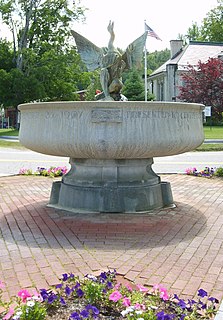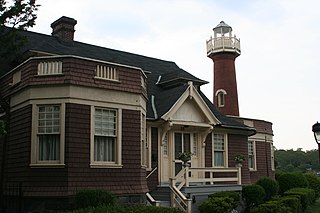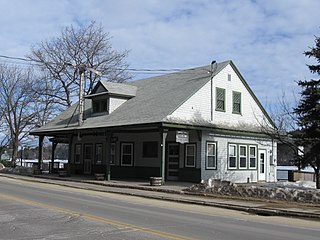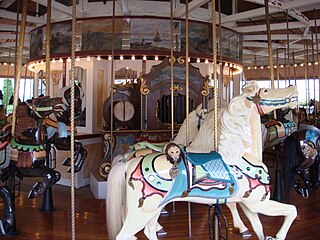
Center Harbor is a town in Belknap County, New Hampshire, United States. As of the 2020 census, the town had a population of 1,040. It is situated between Lake Winnipesaukee and Squam Lake.

Moultonborough is a town in Carroll County, New Hampshire, United States. The population was 4,918 at the 2020 census, up from 4,044 at the 2010 census. Moultonborough is bounded in large part by Lake Winnipesaukee in the southwest and to a lesser extent by Squam Lake in the northwest corner. The town includes the census-designated place of Suissevale and the community of Lees Mill.

Lake Winnipesaukee is the largest lake in the U.S. state of New Hampshire, located in the Lakes Region at the foothills of the White Mountains. It is approximately 21 miles (34 km) long (northwest-southeast) and from 1 to 9 miles wide (northeast-southwest), covering 69 square miles (179 km2)—71 square miles (184 km2) when Paugus Bay is included—with a maximum depth of 180 feet (55 m). The center area of the lake is called The Broads.

Meredith is a town in Belknap County, New Hampshire, United States. The population was 6,662 at the 2020 census. Meredith is situated in the state's Lakes Region and serves as a major resort town. Meredith Village, the commercial center of the town, lies long the shores of Lake Winnipesaukee, and several other large lakes lie partially or completely within the town borders. It is home to the Stonedam Island Natural Area and the Winnipesaukee Scenic Railroad, and it serves as one of the ports of call for the paddle steamer MS Mount Washington.

Lake Kanasatka is a 371-acre (150 ha) lake located in Carroll County in the Lakes Region of central New Hampshire, United States, in the town of Moultonborough. Early maps refer to the lake as "Long Pond", presumably because of its long and narrow shape, "Quinebarge Pond" or "Lake Quinebarge". The lake is located one-half mile north of and nine vertical feet higher than Lake Winnipesaukee. Lake Kanasatka lies at the base of Red Hill and is largely fed by its rain and snow runoff.

Goat Island Light is a lighthouse located off Cape Porpoise near Kennebunkport in southern Maine. Goat Island Light was established in 1835 to guard the entrance to Cape Porpoise Harbor. The original station was upgraded in 1859 to the current brick tower with a fifth order Fresnel lens. Keeper's quarters were added to the island in 1860. The light station was automated by the United States Coast Guard in 1990 and is currently active. The keepers dwellings and tower are leased to the Kennebunkport Conservation Trust. Goat Island Light can be seen from shore in Cape Porpoise Harbor just off State Route 9 north of Kennebunkport or is viewable by boat. The island is currently closed to the public except by special arrangement.

The Manitou Island Light Station is a lighthouse located on Manitou Island, off the tip of Michigan's Keweenaw Peninsula in Lake Superior. It was listed on the National Register of Historic Places in 1984.

North Manitou Island Lifesaving Station, also known as North Manitou Coast Guard Station, is a complex of buildings located on North Manitou Island, which is part of Sleeping Bear Dunes National Lakeshore in Michigan, in the U.S. The complex was constructed as a life-saving station. It is the only remaining station which was in use during all three periods of lifesaving service history, from the early volunteer period through operation by the United States Life-Saving Service and the United States Coast Guard. It was declared a National Historic Landmark in 1998.

The Lighthouse on Turtle Rock is a lighthouse built in 1887 to aid traffic on the Schuylkill River near Philadelphia, Pennsylvania. The lighthouse was constructed by Frank Thurwanger at a cost of $2,663 on an area of land just west of Boathouse Row. The lighthouse has a hexagonal lantern room with an octagonal walkway. Gas was first used to power the light, but in 1990, when the lighthouse was repainted and received a new wooden balustrade and newel posts, the beacon was electrified.

Bear Island Light is a lighthouse on Bear Island near Mt. Desert Island, at the entrance to Northeast Harbor, Maine. It was first established in 1839. The present structure was built in 1889. It was deactivated in 1981 and relit as a private aid to navigation by the Friends of Acadia National Park in 1989. Bear Island Light was listed on the National Register of Historic Places as Bear Island Light Station on March 14, 1988.

The Weeks Estate is a historic country estate on U.S. Route 3 in Lancaster, New Hampshire. Built in 1912 for John Wingate Weeks, atop Prospect Mountain overlooking the Connecticut River, it is one of the state's best preserved early 20th-century country estates. It was given to the state by Weeks' children, and is now Weeks State Park. It features hiking trails, expansive views of the countryside from the stone observation tower, and a small museum in the main estate house. A small portion of property at the mountain summit was listed on the National Register of Historic Places in 1985.

The Centre Harbor Village Historic District encompasses the historic village of Center Harbor, New Hampshire. It consists of a small cluster of properties located north of Plymouth Street and Main Street, as well as the Nichols Memorial Library, and the Kona Fountain, which is located in the center of that intersection. It was added to the National Register of Historic Places in 1983.

Gull Point State Park is a state park of Iowa, United States, located on West Okoboji Lake in the city of Wahpeton. It is the primary state park unit in the Iowa Great Lakes region. Two areas of the park were listed as nationally recognized historic districts on the National Register of Historic Places in 1990.

Lonesomehurst Cabin is a log cabin style recreational residence on the west side of the South Fork Arm of Hebgen Lake near West Yellowstone, in Gallatin County, Montana. Hebgen Lake is on the Madison River. There are three buildings on the site: a wood frame cabin constructed circa 1919, a log boathouse built in 1958, and a wood frame outhouse built about 1930. The cabin is at the south end of the site, which is 8 miles (13 km) west of West Yellowstone and the entrance to Yellowstone National Park.

The South Fox Island Light was a light station located on South Fox Island in the north end of Lake Michigan. There are two towers standing at the site: the first is the original brick keeper's house and tower, while the second is a skeletal tower moved to this site from Sapelo Island, Georgia in 1934. Neither is operational. The station was listed on the National Register of Historic Places in 2021.

The Webster Estate is a historic summer estate in Holderness, New Hampshire. Located near Carns Cove on Squam Lake off New Hampshire Route 113, the estate belongs to the locally prominent Webster family. It includes a number of houses: the Homestead, which was built for the family patriarch, Frank Webster, in 1899, and the 1903 Laurence Webster House. It was one of the largest summer estates on Squam Lake at the time. A 16.4-acre (6.6 ha) remnant of the original 5,000-acre (2,000 ha) estate was listed on the National Register of Historic Places in 1989.

Alton Bay station is a former railroad station on New Hampshire Route 11 in Alton Bay, New Hampshire. Built in 1907 by the Boston and Maine Railroad, it is a surviving reminder of the importance of the railroad to the development of Alton Bay as a summer resort community. The building, now in use as a community center, was listed on the National Register of Historic Places in 1983 as Alton Bay Railroad Station.

Windermere was a historic summer estate at the southern tip of Long Island, the largest island in New Hampshire's Lake Winnipesaukee. Developed in the early 1890s, it was one of the largest country estates on the lake's shores. The main house, a three-story mansion built in 1891–92 by Frank Eugene Greene, is the most elaborate such house built in Moultonborough. A 5-acre (2.0 ha) remnant of the estate, encompassing the former main house and some outbuildings, was listed on the National Register of Historic Places in 1979. The property is now a residential condominium.

Lake Compounce Carousel is a historic carousel at Lake Compounce amusement park in Southington, Connecticut. It was designed by Charles I. D. Looff and built in 1890. A rare surviving operational Looff carousel, it was added to the National Register of Historic Places in 1978.

The Geneva Point Center is a historic summer camp and conference center in Moultonborough, New Hampshire, on Lake Winnipesaukee, and is the name of the non-profit organization which currently owns it. It was founded in 1919, with the site being purchased by the International Sunday School Association to serve as "an eastern site for its Boys' and Girls' Camps." The center is located on 184 acres (74 ha), about 5 miles (8 km) down Moultonborough Neck upon Lake Winnipesaukee, in the Lakes Region of New Hampshire. It has many facilities and accommodations of different types, along with waterfront swimming and boating facilities on the lake. It can hold conferences, camp groups, family groups and other events. The complex includes many historic buildings, including the Winnipesaukee Inn.






















